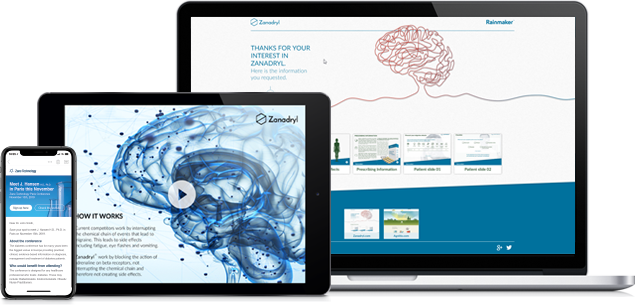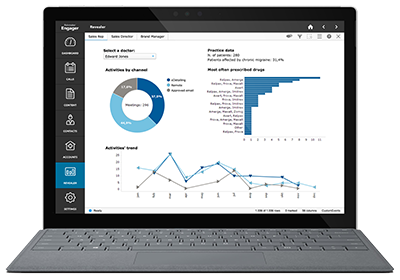6 things
that
pharma
wants
Pharma Digital Strategy:
Six emerging needs
What pharma wants is changing. This is partly in response to an emerging landscape — one that has new players, new voices and where the roles of traditional decision makers are shifting.
New needs also result from changing business models. Companies that are building themselves around patient centricity or an outcomes-based model needs to act in different ways and require the tools to do it.
To discover what’s required today, we spoke with industry thought-leaders and life science executives about the big challenges facing the pharma industry.
So what does pharma want? Agnitio has uncovered six clear needs to inspire your pharmaceutical digital strategy - that are emerging now and likely to only get more pressing in the future.
1 New digital communication tools
With prescribing decisions being taken more centrally by governments, health authorities and insurance companies, the objectives for healthcare professional communications are changing. Couple this with the long-term trend for declining access and it’s easy to see why people are questioning traditional practices — and companies are looking to try something new.
Healthcare professional interactions are increasingly more about ensuring that doctors are getting the best possible results from a product rather than convincing them to use it in the first place. The focus has moved downstream to helping doctors solve their treatment challenges.
New objectives — and often new kinds of customer-facing staff — require new communication tools. In response, digital technology can provide not only on-demand services 24-7 but also empower staff to help solve specific problems like screening, diagnosis and adherence.
Phil Matton
Consultant, SPICE healthcare
Former VP Commercial Strategy, AstraZeneca



Multichannel CLM software
Align marketing and sales efforts. With Rainmaker, you enable personalized engagements via a range of channels and devices, while ensuring compliant and consistent communications. You deliver a unified customer experience, while keeping track of your KPIs with a central hub for your data insights.
Marianne Kryhlmand
Global Brand Manager, Depression Portfolio, Lundbeck
2 Informed patients
There is growing awareness that products need to be better supported throughout the treatment pathway - with a particular focus on ensuring that patients have all the information that they need.
While the delivery of information usually remains the domain of medical professionals, there’s increasing industry interest in supporting them — especially in the face of the on-going trend for empowered, more-demanding patients seeking to be better informed.
Digital communication technology opens up new ways to ‘help doctors help patients’ by empowering healthcare professionals with credible information on-demand, together with the means to deliver it to patients in fast, simple and direct ways. This not only better supports products but also boosts healthcare professional relationships by providing them with more value.
3 More control over communication
As the options for digital communications increase, so does complexity of managing it. Now there are different versions of materials for different markets, new kinds of content provided to multiple types of customer-facing staff, and more channels than ever before.
All this has to be controlled. Knowing what’s where — and what needs to be updated, retired, or adapted — is just the start. Content needs to flow from one channel to the next, customer interactions tracked, data delivered to the right people – with all this happening in a timely way, everywhere the company operates.
Marketers need true content systems that are scalable, reduce human error, and account for the complexity at play — actually making it easier to realize the potential for rich communications that the technology offers.
Philippe Kirby
Director, Customer Engagement Capabilities, MSD
It is enabling a shift ‘beyond the pill’ by allowing us to package service & solutions around a drug and to gain insights on what works and doesn't.
Philippe Kirby
Director, Customer Engagements Capabilities, MSD
4 Digital services
Companies are adapting to a new paradigm, in which providing a product is just part of a solution that delivers the right treatment outcomes. This requires more holistic approaches to your pharma marketing strategy — valuable, outcome-improving services that surround every drug or the medical device.
While this is unfamiliar territory it offers the potential for huge gains for companies that respond to the challenge. Businesses can add value far more quickly with services than via therapeutic product pipelines — especially if digital technology is deployed more effectively.
With expectations that whole regions will become entirely outcomes-based, adding digital service elements provides significant commercial advantage. Yet companies need the systems that enable them to build services around their products.
5 Actionable data
Digital technology has opened up the opportunity to better understand customer needs by tracking content. Now data is flowing in from e-detailing, websites, apps and other channels. What’s missing is a way to manage it and put it to work.
All the data in the world isn’t of use if it’s all piled up. Companies are looking for not just data collection but also an easy way to manage it, with processes that get the information where it needs to go.
Some aggregated customer data needs to be handled in HQ, some by affiliates, some by R&D or market access. Individualized data needs to reach customer-facing staff so they can provide relevant services. Getting data to flow to the right person in a timely way, and in a format that enables it to be actionable, is increasingly essential for your pharmaceutical digital strategy.
Beth Wolff
Head of Commercial Excellence Nordics, Sandoz
creating experiences now rather than building channels. To do this, there needs to be flexible systems that allow different channels to work together holistically.
Lars U Diemer
CEO, Agnitio
6 Connected multichannel: Digital transformation in pharma
The spectacular growth in digital channels in recent years has actually started to become a problem. If you search for diabetes apps you will find hundreds of examples. The sheer number of websites, social media projects and mobile applications can be confusing for their intended audiences.
What’s in focus now is not the actual channels but the relationship between them. Rather than a series of isolated initiatives, companies are increasingly asking how to provide coherent, holistic customer experiences.
What’s needed is an ecosystem of connected channels. Patients might move between web-based communications, social media and mobile apps; while healthcare professionals travel from e-detailing to portals and back again. What matters is the experience that’s delivered.


